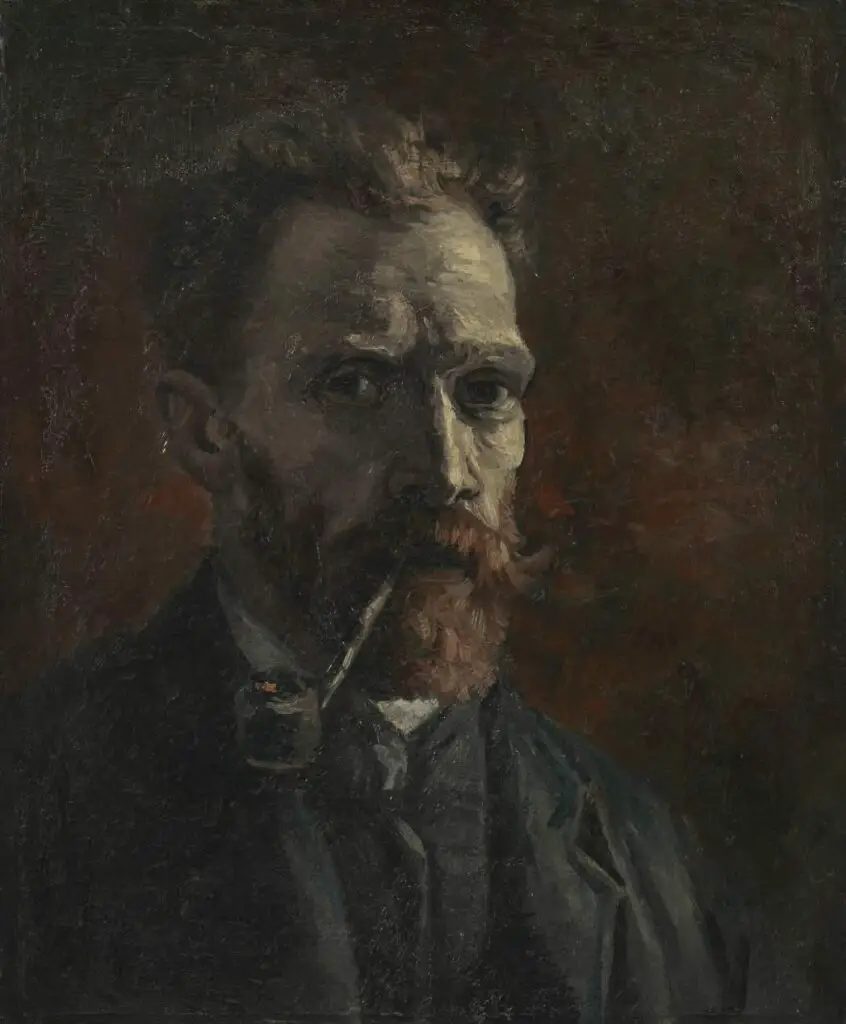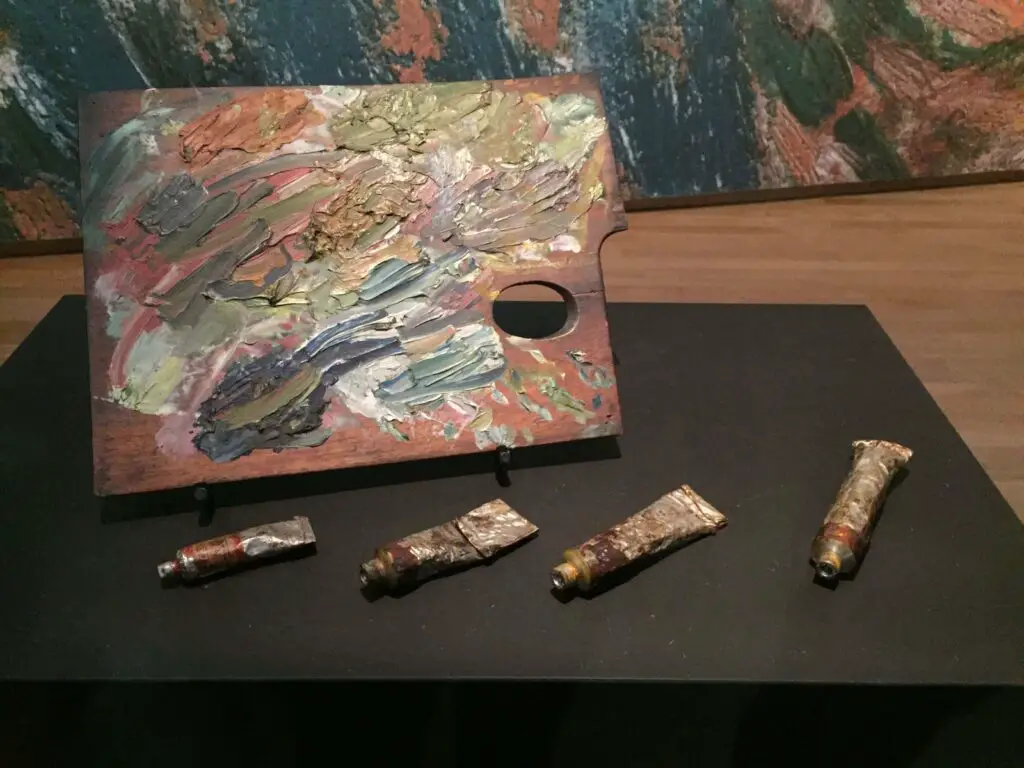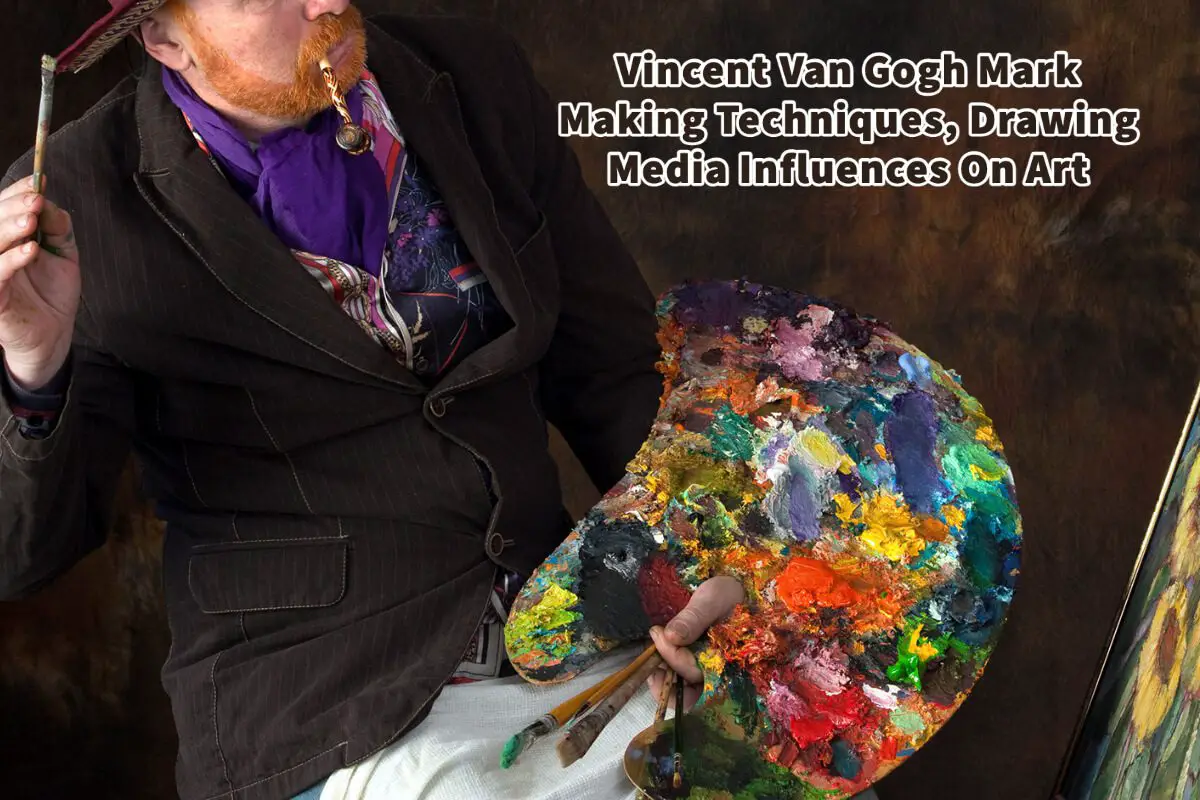An artist’s use of materials can directly influence their style of painting. This was particularly true with Vincent Van Gogh and his unique painting style.
Vincent Van Gogh used fascinating mark-marking techniques to use materials for his drawings and other media. Van Gogh used pencils, pens, ink, and paints. He also had unique brushstrokes in how he executed his painting. Japanese woodblock prints and Japanese art influenced Van Gogh.
Table of Contents
- Vincent Van Gogh’s Choice Of Drawing Media Choices In His Art
- Van Gogh’s Use Of Brush And Colors
- Van Gogh’s Inspiration For Prints And Use Of Print
- Frequently Asked Questions
- Related Questions
Vincent Van Gogh’s Choice Of Drawing Media Choices In His Art
Vincent van Gogh’s art materials help to influence his overall artistic style and his paintings. Everything from how he approached his drawing to his actual painting.

Here are some drawing media he used for his artistic work.
Van Gogh’s Use Of Pencils
Vincent van Gogh used pencils as a way to draw. He would then combine the pencils with ink.
The pencil that Van Gogh used was known as a carpenter pencil. A carpenter pencil is a pencil that has a body with a rectangular or elliptical cross-section to prevent it from rolling away. Carpenter pencils are known to be easy to grip and have become standard pencils because they have a larger surface area.
A carpenter pencil was ideal for Vincent van Gogh and his drawing style as he liked to press hard on paper when using a pencil. He would often draw on wet paper.
Van Gogh’s Use Of Pen And Ink
Van Gogh had an art technique for his pencil and graphic drawings. He had a remarkable gift for pen drawings.
Here are a few things to remember about Vincent Van Gogh’s pen and ink drawings:
- Used Pencil First And Then Ink And Pen – Vincent van Gogh would first work in pencil, then used ink and pens to review the pencil marks.
- Some Drawing Without Any Pencils – Some of his drawings were straight pen and ink on dry paper without a pencil.
- Used The Reed Pen – The Reed Pen was made from local hollow-barreled grass and then sharpened with a pen knife. The use of this Reed Pen changed his way of drawing.
In speaking of his drawing technique, in a letter to his brother Theo, Vincent Van Gogh wrote this:
“Because up to now I’ve been drawing with pencil only, worked up or heightened with the pen, if necessary with a reed pen, which makes broader lines.
Vincent Van Gogh to Theo van Gogh – 18 Dec 1881
That manner of working was implicit in what I’ve been drawing lately, for they were subjects which required a lot of drawing, also drawing in perspective, namely several workshops here in the village, a smithy, a carpenter’s shop and a clog-maker.”
From this letter, we learn about Vincent Van Gogh’s uniqueness; he would use a pencil and pen and then a reed pencil for some broader lines.
Van Gogh’s Use Of Brush And Colors

One of the unique aspects of Vincent Van Gogh’s art is how he used his brushes to make marks on the canvas. He did this in a way that other artists did not.
He also had a great sense of color and used unique color combinations for his time. He was known to love colors such as yellows and blue. In speaking of his painting, he said:
““Painting it was hard graft. There are one and a half large tubes of white in the ground — yet that ground is very dark — in addition red, yellow, brown ochre, black, terra sienna, bistre, and the result is a red-brown that varies from bistre to deep wine-red and to pale, blond reddish…As you see, I’m immersing myself in painting with all my strength — I’m immersing myself in colour — I’ve held back from that until now, and don’t regret it.”
Vincent Van Gogh To Theo – 3 September 1882
Van Gogh’s Inspiration For Prints And Use Of Print
Like many artists during his time, Vincent Van Gogh was fascinated with Japanese woodblock prints. He was known to hang them in his studio and get inspiration from them. In speaking of the influence he received from the Japanese, Vincent Van Gogh said:
“I hope to make some of these croquis after the painted studies for you too; you’ll see that it has a certain Japanese look.”
Vincent Van Gogh To theo – 31 July 1888
We love Vincent Van Gogh; even though he sold very few paintings when he was alive, he is considered one of the greatest artists ever. He deserves his place among the great artists of the world.
Great artists like Vincent van Gogh inspire me. Anita Louise Art is dedicated to art education, great artists, and inspiring others to find and create their art. We love art that uplifts and inspires. #ArtToMakeYouSmile! #ArtToMakeYouHappy!
Anita Louise Art is dedicated to art education, great artists, and inspiring others to find and create their art. We love art that uplifts and inspires. #ArtToMakeYouSmile! #ArtToMakeYouHappy!
If you want to see any of my art, you can find out more by clicking here. If you are interested in what inspires me and my paintings, you can discover more by clicking here.
We have a free newsletter and would love you to be part of our community; you can subscribe to the newsletter by clicking here. If you have any questions, I would be happy to talk to you. You can reach me, Anita, by clicking here.
Subscribe to our Anita Louise Art YouTube Channel filled with great videos and information by clicking here.
Join us for our podcast “5 Minutes With Art.” Spend just 5 minutes a week with us to discover and learn about great art and artists. You can find out more about our podcast by clicking here.
Frequently Asked Questions
What drawing materials did Vincent Van Gogh commonly use in his artworks?
Van Gogh utilized a variety of drawing materials, including pencils, pens, ink, and paints, to create his distinctive artworks.
How did Van Gogh employ unique mark-making techniques in his drawings?
Van Gogh’s mark-making techniques were characterized by bold, expressive strokes. He often used hatching and cross-hatching to create texture and depth in his drawings.
What is notable about Van Gogh’s use of brushstrokes in his paintings?
Van Gogh’s paintings are known for their thick and expressive brushstrokes. He applied paint in a way that conveyed his emotions and energy, contributing to the overall emotional intensity of his works.
How did Japanese woodblock prints influence Van Gogh’s art?
Van Gogh was greatly influenced by Japanese woodblock prints, which is evident in his use of flattened perspectives and bold outlines. He admired the simplicity and vibrant colors of Japanese art.
Did Van Gogh incorporate Japanese art themes into his own work?
Yes, Van Gogh was inspired by Japanese themes, such as landscapes, flowers, and everyday scenes. He incorporated elements of Japanese art into his paintings, adapting them to his unique style.
How did Japanese art impact Van Gogh’s color palette?
Japanese art influenced Van Gogh’s color choices, inspiring him to experiment with vibrant and unconventional color combinations. This departure from traditional palettes contributed to the distinctiveness of his art.
Did Van Gogh’s use of drawing media evolve over the course of his career?
Yes, Van Gogh’s use of drawing media evolved throughout his career. In his early works, he used more traditional techniques, but as he developed his unique style, his mark-making became bolder and more expressive.
How did Van Gogh’s use of drawing media contribute to the emotional impact of his art?
Van Gogh’s use of expressive mark-making and bold brushstrokes added emotional depth to his artworks. The visible energy in his strokes conveyed his emotional state and contributed to the intensity of the viewer’s experience.
What role did Van Gogh’s mental health play in shaping his mark-making techniques?
Van Gogh’s mental health struggles had a significant impact on his art. His turbulent emotions were often reflected in the intensity of his mark-making, contributing to the emotional rawness of his works.
How did Van Gogh’s innovative use of materials influence later artists?
Van Gogh’s bold approach to mark-making and use of unconventional materials inspired many artists who came after him. His influence can be seen in the evolution of art styles and techniques throughout the 20th century.
Related Questions
42 Motivational And Inspiring Quotes By The Artist Vincent Van Gogh
What makes Vincent Van Gogh’s quotes so interesting is that Vincent Van Gogh did not have an easy life. He suffered from psychotic episodes and delusions He worried about his mental health. He was known not to eat properly and he drank heavily.
By clicking here, you can learn more by reading 42 Motivational And Inspiring Quotes By The Artist Vincent Van Gogh.
Who Is the Japanese Woodblock Print Artist Utagawa Kuniyoshi (1798 – 1861)?
Utagawa Kuniyoshi was a Japanese artist who was a ukiyo-e art style woodblock print master. His woodblock prints are artistic masterpieces. Kuniyoshi became an artist early in life, but success did not always come easy to him. He eventually became very popular as his artwork influenced the trends and fashions of his day.
By clicking here, you can learn more by reading Who Is the Japanese Woodblock Print Artist Utagawa Kuniyoshi (1798 – 1861)?
How Much Is Van Gogh’s Starry Night Worth, And Other Facts
The Vincent van Gogh Starry Night painting is considered priceless; many have estimated that the artwork is worth over 100 million US dollars. The Museum of Modern Art in New York City has had the painting in its collection since 1941.
By clicking here, you can discover more by reading How Much Is Van Gogh’s Starry Night Worth, And Other Facts.

